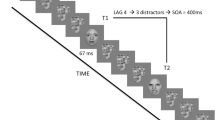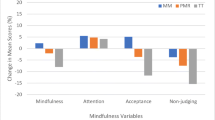Abstract
While mindfulness meditation has been associated with enhanced attentional abilities, the consequences of loving-kindness meditation for attention have not previously been investigated. We examined the trait and state effects of 8 weeks of training in loving-kindness meditation (LKM) on the attentional blink. The attentional blink is a period of time in which a target stimulus is less likely to be detected if it follows too quickly (approximately 500 ms) after a previously detected target. For the two experiments reported here, a group of participants trained in LKM by meditating for approximately 15 min per day, four days per week, for 8 weeks. Experiment 1 utilized a pre-post design, with a non-meditating control group, to examine whether this training reduced the attentional blink. No differences were found. However, in an exploratory analysis, meditators did exhibit increases in two facets of mindfulness measured by the Five Facet Mindfulness Questionnaire: observation and descriptiveness. In experiment 2, we tested for a state effect of LKM by having trained meditators practice LKM immediately prior to the attentional blink task. Here, meditators had a significantly reduced blink size compared to control participants. To establish that this reduction was caused by the combination of LKM training with pre-task meditation, we analyzed the data in experiment 2 with respect to one of our previous works, which reported that the practice of LKM immediately prior to the attentional blink task in those without meditation training did not reduce the blink magnitude. This analysis also revealed a significant difference. Therefore, training in LKM, coupled with its practice immediately prior to an attention task, caused a state reduction in the attentional blink. These results are the first to demonstrate that LKM, an emotion-focused practice, influences cognitive processing.




Similar content being viewed by others
References
Arend, I., Johnston, S., & Shapiro, K. (2006). Task-irrelevant visual motion and flicker attenuate the attentional blink. Psychonomic Bulletin & Review, 13, 600–607.
Baer, R. A., Smith, G. T., Hopkins, J., Krietemeyer, J., & Toney, L. (2006). Using self-report assessment methods to explore facets of mindfulness. Assessment, 13, 27–45.
Baer, R., Smith, G. T., Lykins, E., Button, D., Krietemeyer, J., Sauer, S., et al. (2008). Construct validity of the five facet mindfulness questionnaire in meditating and non-meditating samples. Assessment, 15(2), 329–342.
Barnhofer, T., Chittka, T., Nightingale, H., Cisser, C., & Crane, C. (2010). State effects of two forms of meditation on prefrontal EEG asymmetry in previously depressed individuals. Mindfulness, 1, 21–27. doi:10.1007/s12671-010-0004-7.
Basso, M. R., Schefft, B. K., Ris, M. D., & Dember, W. N. (1996). Mood and global-local visual processing. Journal of the International Neuropsychological Society, 2, 249–255.
Benet-Martinez, V., & John, O. P. (1998). Los Cinco Grandes across cultures and ethnic groups: multitrait multimethod analyses of the big five in Spanish and English. Journal of Personality and Social Psychology, 75, 729–750.
Braun, J. (1998). Vision and attention: the role of training. Nature, 393, 424–425.
Brefczynski-Lewis, J. A., Lutz, A., Schaefer, H. S., Levinson, D. B., & Davidson, R. J. (2007). Neural correlates of attentional expertise in long-term meditation practitioners. Proceedings of the National Academy of Sciences, 104(27), 11483–11488.
Brown, K. W., & Ryan, R. M. (2003). The benefits of being present: mindfulness and its role in psychological well-being. Journal of Personality and Social Psychology, 84, 822–848.
Burgard, M., & May, C. J. (2010). The effect of positive affect induction via metta meditation on the attentional blink. Journal for Articles in Support of the Null Hypothesis, 7(1), 8–15.
Carmody, J., & Baer, R. A. (2008). Relationships between mindfulness practice and levels of mindfulness, medical and psychological symptoms and well-being in a mindfulness-based stress reduction program. Journal of Behavioral Medicine, 31, 23–33. doi:10.1007/s10865-007-9130-7.
Carson, J. W., Keefe, F. J., Lynch, T. R., Carson, K. M., Goli, V., Fras, A. M., et al. (2006). Loving-kindness meditation for chronic low back pain. Journal of Holistic Nursing, 23(3), 287–304. doi:10.1177/0898010105277651.
Carter, O. L., Presti, D. E., Callistemon, C., Ungerer, Y., Liu, G. B., & Pettigrew, J. D. (2001). Meditation alters perceptual rivalry in Tibetan Buddhist monks. Current Biology, 15(11), R412.
Compton, R., Wirtz, D., Pajoumand, G., Claus, E., & Heller, W. (2004). Association between positive affect and attentional shifting. Cognitive Therapy and Research, 28(6), 733–744.
Derryberry, D., & Tucker, D. M. (1994). Motivating the focus of attention. In P. M. Neidenthal & S. Kitayama (Eds.), The heart’s eye: emotional influences in perception and attention (pp. 167–196). San Diego: Academic.
Dorjee, D. (2010). Kinds and dimensions of mindfulness: why it is important to distinguish them. Mindfulness, 1, 152–160. doi:10.1007/s1267-010-0016-3.
Dreisbach, G., & Goschke, T. (2004). How positive affect modulates cognitive control: reduced perseveration at the cost of increased distractibility. Journal of Experimental Psychology. Learning, Memory, and Cognition, 30, 343–353.
Ekman, P., Davidson, R., Ricard, M., & Wallace, A. (2005). Buddhist and psychological perspectives on emotions and well being. Current Directions in Psychological Science, 14(2), 59–63.
Fredrickson, B. L. (1998). What good are positive emotions? Review of General Psychology, 2, 300–319.
Fredrickson, B. L., & Branigan, C. (2005). Positive emotions broaden the scope of attention and thought-action repertoires. Cognition and Emotion, 19(3), 313–332.
Fredrickson, B. L., Cohn, M. A., Coffey, K. A., Pek, J., & Finkel, S. M. (2008). Open hearts build lives: positive emotions, induced through loving-kindness meditation, build consequential personal resources. Journal of Personality and Social Psychology, 95(5), 1045–1062. doi:10.1037/a0013262.
Gasper, K., & Clore, G. L. (2002). Attending to the big picture: mood and global versus local processing of visual information. Psychological Science, 13, 34–40.
Hutcherson, C. A., Seppala, E. M., & Gross, J. J. (2008). Loving-kindness meditation increases social connectedness. Emotion, 8(5), 720–724. doi:10.1037/a0013237.
Isen, A. M. (1987). Positive affect, cognitive processes, and social behavior. Advances in Experimental Social Psychology, 20, 203–253.
James, W. (1918). The principles of psychology, Vol. 1. New York: Holt.
Jefferies, L. N., Smilek, D., Eich, E., & Enns, J. T. (2008). Emotional valence and arousal interact in attentional control. Psychological Science, 19(3), 290–295.
John, O. P., Donahue, E. M., & Kentle, R. L. (1991). The big five inventory–versions 4a and 54. Berkeley: University of California, Berkeley, Institute of Personality and Social Research.
John, O. P., Naumann, L. P., & Soto, C. J. (2008). Paradigm shift to the integrative big-five trait taxonomy: history, measurement, and conceptual issues. In O. P. John, R. W. Robins, & L. A. Pervin (Eds.), Handbook of personality: theory and research (pp. 114–158). New York: Guilford Press.
Johnson, D. P., Penn, D. L., Fredrickson, B. L., Meyer, P. S., Kring, A. M., & Brantley, M. (2009). Loving-kindness meditation to enhance recovery from negative symptoms of schizophrenia. Journal of Clinical Psychology: In Session, 65(5), 499–509. doi:10.1002/jclp.20591.
Lutz, A., Greischar, L. L., Rawlings, N. B., Ricard, M., & Davidson, R. J. (2004). Long-term meditators self-induced high-amplitude gamma synchrony during mental practice. PNAS, 101(46), 16369–16373.
Lutz, A., Brefczynski-Lewis, J., Johnstone, T., & Davidson, R. J. (2008). Regulation of the neural circuitry of emotion by compassion meditation: effects of meditative expertise. PLoS ONE, 3(3), e1897. doi:10.1371/journal.pone.0001897.
Lutz, A., Slagter, H. A., Dunne, J., & Davidson, R. J. (2008). Attention regulation and monitoring in meditation. Trends in Cognitive Sciences, 12(4), 163–169.
MacLean, M. H., & Arnell, K. M. (2010). Personality predicts temporal attention costs in the attentional blink paradigm. Psychonomic Bulletin & Review, 17, 556–562.
MacLean, M., Arnell, K., & Busseri, M. (2010). Dispositional affect predicts temporal attention costs in the attentional blink paradigm. Cognition and Emotion, 24(8), 1431–1438.
McCraty, R., Atkinson, M., Tiller, W. A., Rein, G., & Watkins, A. D. (1995). The effects of emotions on short-term power spectrum analysis of heart rate variability. The American Journal of Cardiology, 76(14), 1089–1093.
McCraty, R., Barrios-Choplin, B., Rozman, D., Atkinson, M., & Watkins, A. D. (1998). The impact of a new emotional self-management program on stress, emotions, heart rate variability, DHEA, and cortisol. Integrative Physiological and Behavioral Science, 33(2), 151–170.
Moore, A., & Malinowski, P. (2009). Meditation, mindfulness, and cognitive flexibility. Consciousness and Cognition, 18, 176–186.
Olivers, C. N. L., & Nieuwenhuis, S. (2005). The beneficial effect of concurrent task-irrelevant mental activity on temporal attention. Psychological Science, 16, 265–269.
Olivers, C. N. L., & Nieuwenhuis, S. (2006). The beneficial effects of additional task load and positive affect on the attentional blink. Journal of Experimental Psychology: Human Perception and Performance, 32, 364–379.
Pace, T. W. W., Negi, L. T., Adame, D. D., Cole, S. P., Sivilli, T. I., Brown, T. D., et al. (2009). Effect of compassion meditation on neuroendocrine, innate immune and behavioral responses to psychosocial stress. Psychoneuroendocrinology, 34(1), 87–98. doi:10.1016/j.psyneuen.2008.08.011.
Raymond, J. E., Shapiro, K. L., & Arnell, K. M. (1992). Temporary suppression of visual processing in an RSVP task: an attentional blink? Journal of Experimental Psychology: Human Perception and Performance, 18(3), 849–860.
Rowe, G., Hirsh, J. B., & Anderson, A. K. (2007). Positive affect increases the breadth of attentional selection. Proceedings of the National Academy of Sciences, 104(1), 383–388.
Salzberg, S. (1995). Loving-kindness: the revolutionary art of happiness. Boston: Shambhala.
Shapiro, K. L., Arnell, K. M., & Raymond, J. E. (1997). The attentional blink. Trends in Cognitive Sciences, 1(8), 291–296.
Shapiro, S. L., Astin, J. A., Bishop, S. R., & Cordova, M. (2005). Mindfulness-based stress reduction for health care professionals: results from a randomized trial. International Journal of Stress Management, 12, 164–176.
Shapiro, S. L., Warren Brown, K., & Biegel, G. M. (2007). Teaching self-care to caregivers: effects of mindfulness-based stress reduction on the mental health of therapists in training. Training and Education in Professional Psychology, 1(2), 105–115.
Slagter, H. A., Lutz, A., Greischar, L. L., Francis, A. D., Nieuwenhuis, S., Davis, J. M., et al. (2007). Mental training affects distribution of limited brain resources. PLoS Biology, 5(6), 0001–0008.
Srinivasan, N., Srivastava, P., Lohani, M., & Baijal, S. (2009). Focused and distributed attention. Progress in Brain Research, 176, 87–100. doi:10.1016/S0079-6123(09)17606-9.
Taatgen, N. A., Juvina, I., Schipper, M., Borst, J. P., & Sander, M. (2009). Too much control can hurt: a threaded cognition model of the attentional blink. Cognitive Psychology, 59(1), 1–29.
Tang, Y., Ma, Y., Fan, Y., Feng, H., Wang, J., Feng, S., et al. (2009). Central and autonomic nervous system interaction is altered by short-term meditation. Proceedings of the National Academy of Sciences, 106(22), 8865–8870.
Tiller, W. A., McCraty, R., & Atkinson, M. (1996). Cardiac coherence: a new, noninvasive measure of autonomic nervous system order. Alternative Therapies, 2(1), 52–65.
Tomarken, A., Davidson, R. J., Wheeler, R. E., & Doss, R. C. (1992). Individual differences in anterior brain asymmetry and fundamental dimensions of emotion. Journal of Personality and Social Psychology, 62(4), 676–687.
van Leeuwen, S., Muller, N. G., & Melloni, L. (2009). Age effects on attentional blink performance in meditation. Consciousness and Cognition, 18(3), 593–599.
Wallace, B. A., & Shapiro, S. L. (2006). Mental balance and well-being: building bridges between Buddhism and western psychology. The American Psychologist, 61(7), 690–701.
Ward, L. M. (2003). Synchronous neural oscillations and cognitive processes. Trends in Cognitive Sciences, 7(12), 553–559.
Watson, D., Clark, L. A., & Tellegen, A. U. (1988). Development and validation of brief measures of positive and negative affect: the PANAS scales. Journal of Personality and Social Psychology, 54(6), 1063–1070.
Zeiden, F., Johnson, S. K., Diamond, B. J., David, Z., & Goolkasian, P. (2010). Mindfulness meditation improves cognition: evidence of brief mental training. Consciousness and Cognition, 19, 597–605.
Author information
Authors and Affiliations
Corresponding author
Rights and permissions
About this article
Cite this article
May, C.J., Burgard, M., Mena, M. et al. Short-Term Training in Loving-Kindness Meditation Produces a State, But Not a Trait, Alteration of Attention. Mindfulness 2, 143–153 (2011). https://doi.org/10.1007/s12671-011-0053-6
Published:
Issue Date:
DOI: https://doi.org/10.1007/s12671-011-0053-6




